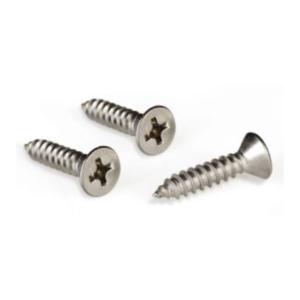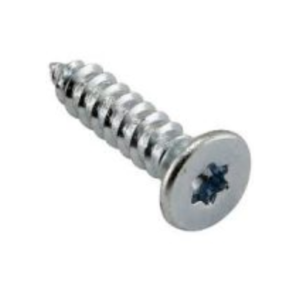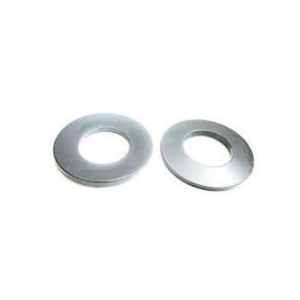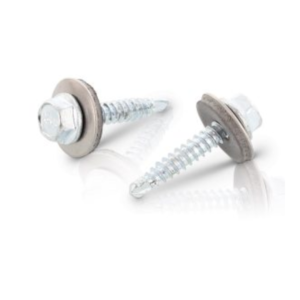-
CSK Phillips Self Tapping Screws
A self-tapping screw is a screw that can tap its own hole as it is driven into the intended material. These are different from traditional screws as they tap their own threads when screwed into either plastic, wood or metal.
Phillips(Cross Recessed) self-tapping
Cross recess H (Phillips) according to ISO 4757
- The Phillips cross recessed head is the world’s most widely used system.
- Has a conventional cruciform recess with all walls inclined, the end of the screwdriver having trapezoid webs.
- The general dimensions are given in the product information of the respective catalogue group.
-
CSK Self Drilling Screws
A Self-Drilling Screw is a Self-Tapping Screw with the added feature of a drill point. The drill point looks a lot like the point of a drill. It will drill a hole and form the mating threads in one operation.
CSK Phillips
A self drilling screw with a CSK head has a flat top surface. This makes it suitable for softer materials such as wood by allowing a flush fit. The single operation of drilling, tapping and fastening wood to metal makes for speedy installation. This saves both time and effort.
Available as per DIN-7504O
For a flush fixing. Useful for fixing wood to metal or other metals having sufficient thickness to provide a countersink. Less prone to theft and tampering.
-
CSK Torx Machine Screws 6-Lobe
The notion of a drive with hexalobular sockets are a decisive step in developing drives better adapted to manual and automated assembly. This drive is becoming increasingly popular throughout the world.
Features
- Standard – ISO 14581
- Our range of CSK Torx head screws is presently in Stainless Steel.
- Gives a flush finish
- Materials: AISI-304 AISI-316
- Size Range: M1.6 to M10 up to 150mm length
- Finish – Passivated. Black coating on special orders
-
Disc and Conical Spring Washers
These are used for locking a device and reducing the vibration. They reduce loosening by preventing unscrewing rotation of the fastening device; locking washers are usually also spring washers.
Washers are available in a wide range such as spring washers, star washers, multi-tooth washers, disc spring washers, wave washers, taper washers, safety washers etc.
Conical Spring Washers
DIN 6796
A Conical spring washer designed to help prevent loosening of bolted joints under vibration. This type, manufactured to DIN 6796 has an inherent conical shape. It is also known as a Belleville washer, disc spring, coned-disc spring and cupped disc washer.
-
Disc and Conical Spring Washers
These are used for locking a device and reducing the vibration. They reduce loosening by preventing unscrewing rotation of the fastening device; locking washers are usually also spring washers.
Washers are available in a wide range such as spring washers, star washers, multi-tooth washers, disc spring washers, wave washers, taper washers, safety washers etc.
Conical Spring Washers
DIN 6796
A Conical spring washer designed to help prevent loosening of bolted joints under vibration. This type, manufactured to DIN 6796 has an inherent conical shape. It is also known as a Belleville washer, disc spring, coned-disc spring and cupped disc washer.
-
Flange Bolts
We offer a wide range of metal bolts and studs. What is the difference between screws and bolts?
Bolts can be described as long shafts with a distinct head on one side. These are generally partially threaded. A fully threaded bolt is referred to as a screw.
Flange Bolts
Flange bolts, also called Hex Flange Screws, are a special type of bolt which have a flange below its head. They look like a bolt with a washer attached to the head.
The flange provides a more even distribution of the load. Flange bolts eliminate the need to use a washer giving higher flexibility in a wide range of operations.
Standard – DIN 6921.
Materials – Mild Steel and Stainless Steel.
-
Flush Nuts
If you have a need for an industrial fastener that, after installation, will be completely flush with its surrounding surface, then the self-clinching flush nut should be your fastener of choice.
This type of insert nuts for flush insertion on both sides are flush with the top and bottom of the sheet metal.
These fasteners are ideal for applications where a thin sheet requires load-bearing threads but still must remain smooth, with no protrusions on either surface. This can provide strong threads in places which would be inaccessible for installation after chassis are formed.
Utilising a special proven clinch feature, this fastener has excellent torque-out and push-out characteristics whilst providing a flush finish on both sides of the panel. The hexagonal head ensures high axial and torsional strength.
Like all self clinching fasteners they are installed using a parallel squeezing action, so require access to both sides of the panel.
Advantages
- Ease of installation: All that is required to successfully install the nut is a simple parallel press device which can be used to push the flush nut into position.
- Suitable for use in thin metal: Provides a strong attachment in metal as thin as 1.6mm with a FLUSH finish.
- No hole preparation required: Eliminates the need for deburring or refinishing.
- Material suitability: Self-clinching flush nuts can be used in a wide variety of materials, including materials that are not conducive to welding.
- No secondary operations: Eliminates the need for additional tapping after installation.
- Insertion automation: Insertion process may be fully automated, thereby increasing process speed and reducing overall production costs.
- These Type F self-clinching nuts particularly can be installed flush before bending or forming operations get under way without risking potential interference problems that protruding fasteners could cause down the line.
Like all self-clinching fasteners they are installed using a parallel squeezing action, so require access to both sides of the panel.
Flush Nuts are available in various thread sizes, manufactured from 300 series stainless steel and are suitable for installation in ductile steel and aluminium panels with a recommended maximum hardness of 70 HRB
-
Hex Bolts & Screws
We offer a wide range of metal bolts and studs. What is the difference between screws and bolts?
Bolts can be described as long shafts with a distinct head on one side. These are generally partially threaded.
A fully threaded bolt is referred to as a screw.
Hex screws:

The work horse of any industry, the ubiquitous screw is needed in every machinery in some size or the other. We have a varied range to cater to all your different needs.
Metric Series:
IS 1364, ISO 4017, DIN 933
Materials: Titanium, Alloy Steel (high tensile), mild steel, Brass and stainless steel (AISI 304 and 316)
Mechanical:
For alloy steel property class 8.8 and 10.9 as per IS 1367, ISO 898 part I.
For mild steel 4.6 class
For Stainless Steel property class 50, 70 and 80[High Strength]
Size Range : M2.5 to M36 .Lengths from 10mm to 400mm
Inch Series
BSW: BS-1083
Threads: BS Whitworth, BS 84
Materials: Titanium, Alloy Steel (high tensile), mild steel and stainless steel AISI304 & AISI316
Mechanical: BS 2470 for Alloy Steel. Size range:(1/8”), 3/16”, ¼”, 5/16”. 3/8”, (7/16”), ½”, 5/8”, 3/4”, (7/8”), (1”). Lengths 3/8” to 8”Sizes in brackets are non-preferred standards and availability is limited.
Hex Bolts:
Metric Series:
 DIN 931 ISO 4014
DIN 931 ISO 4014Materials: Titanium, Alloy Steel (high tensile), mild steel, Brass and stainless steel (AISI 304 and 316)
Mechanical:
For alloy steel property class 8.8 and 10.9 as per IS 1367, ISO 898 part I.
For mild steel 4.6 class
For Stainless Steel property class 50, 70 and 80[High Strength]
Size Range : M2.5 to M36 .Lengths from 10mm to 400mm
-
Hex Self Drilling Screws
A Self-Drilling Screw is a Self-Tapping Screw with the added feature of a drill point. The drill point looks a lot like the point of a drill. It will drill a hole and form the mating threads in one operation.
Hex Heads are available in different materials for use in a number of applications.
- Carbon Steel
- Stainless Steel AISI-304
- Stainless Steel AISI-316
Bi-Metal – SS-304 with Carbon Steel Drill point
Bi-Metal self-drilling tapping screws that provide the corrosion resistance of 300 series stainless steel and the efficiency of drill screws. Such screws avoid the shortcomings of each of these materials.
The whole screw is protected with a silver slide coat. This coating not only adds additional corrosion protection it also reduces the screw in resistance.
This screws can be used for up to two sheets of 1.00mm stainless steel (2.00mm total thickness). The hardened point cuts through the steel then the 304 screws are designed to last a long time without corrosion and can also be used with 316 sheet or cladding. This is a much better option than either a carbon steel screw or a 410 stainless screw that will be at risk of corrosion.
They are suitable for use in both steel and aluminum.












